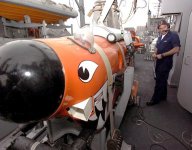

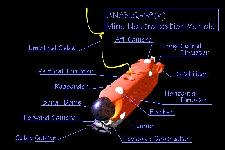
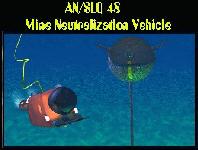
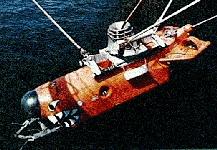
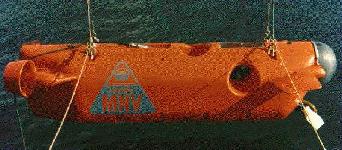



The MCM 1 class holds two AN/SLQ-48 vehicles onboard to counter the threat of mines. The main difference between the installation on the two classes is the vehicle launch/recovery system. The MCM Class has a burtoning (yard and stay) rig, starboard, amidships, while the MHC 51 uses an articulated crane on the fantail.
The mine neutralization vehicle is a self-propelled remote-controlled submarine. The vehicle's low acoustic and magnetic signature make it virtually invisible to even the most modern sea mines. The Mine Neutralization Vehicle is the primary subsystem of the Navy's Mine Neutralization System (MNS). The vehicle has a long body and is powered by a central electrohydraulic system which drives its thrusters. The streamlined external fairing is of fiberglass, and buoyancy is provided by syntactic foam. The sensor package consists of a mine-hunting sonar and two television cameras. In addition to the vehicle, MNS consists of an Umbilical Cable Handling System (UCHS), Vehicle Handling System (VHS), shipboard power supply, and associated control consoles. All these components were developed by SSC San Diego. The system works in conjunction with a shipboard mine hunting sonar and precise inertial navigation system.
Electrical power and data are transmitted via a neutrally-buoyant, 3,500 foot long umbilical cable. If the umbilical cable separates, the vehicle automatically returns to the surface and activates its responder and flasher. The cable is handled by the Umbilical Cable Handling System, which utilizes a winch designed to pay out and take up cable while maintaining a constant cable tension. The vehicle is powered by a 2,500V transformer, which is located in the UCHS room. The vehicle moves underwater by way of its four thrusters, located on the aft and mid part of the fuselage. One thruster provides vertical momentum, one provides sideways momentum, while the other two propel the vehicle forward. Navigation and minehunting are facilitated by two video cameras, fore and aft, a sonar dome, and several powerful lamps.
The vehicle's mission packages are all located forward. The MNS presently carries two mission packages -- one to cut the mooring cable of moored mines, allowing them to rise to the surface for subsequent neutralization or recovery/exploitation (MP-1) and one to destroy bottom mines by placing an explosive charge near the mine (MP-2). A new mission package, MP-3, to destroy moored mines in-place recently successfully completed its Follow-On Operational Test and Evaluation (FOT&E). The FOT&E report was approved and signed by COMOPTEVFOR on 4 Nov 96 and stated that MP-3 was "operationally effective and suitable," and recommended it for Fleet introduction.While in operation, the minehunting sonar makes initial contact with the target mine. The Mine Neutralization Vehicle is deployed using the vehicle handling system to visually identify objects under the water. Using the control console located in the ship's Combat Information Center, the vehicle's pilot can guide the vehicle under the water towards the target. The MNV, powered through an umbilical cable from the ship, is given a vector to the target by ship sonar information. The operator flies the MNV based on the vehicle sonar and/or TV information. The MNV is flown by the operator toward the target using an installed tracking system until the vehicle�s own sensors acquire the target. Once within range, the vehicle sends back a real-time video image of the object. If the object is identified as a mine, the vehicle can deploy an explosive charge on the bottom mine, or the explosive cutter on the mooring cable of the moored mine. Once the explosive is in place, the MNV is returned to the ship, and the explosive device is actuated by a coded acoustic signal broadcast by the she ship's hydrophone. The system was developed by Honeywell for the US Navy.
The Mine Neutralization System (MNS) and the minehunting sonar constitute the main difference between WWII and modern day mine countermeasures. WWII mine countermeasures emphasized minesweeping, emphasis today tends toward minehunting and neutralization due to the complexity of some modern influence mines, which make sweeping extremely difficult. There are ocean areas where rocks and other bottom clutter make minehunting ineffective so ships need both minesweeping and minehunting capability. The effectiveness of these tools has been proven again and again in both practice and actual minehunting missions.





